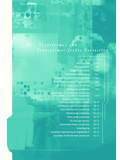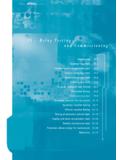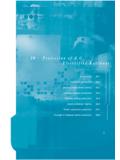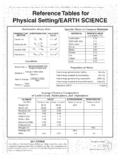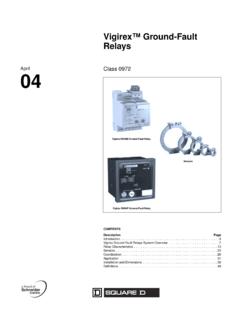Transcription of 9 Overcurrent Protection for Phase and Earth Faults
1 Of time/current Overcurrent and high set instantaneous Overcurrent Inverse Overcurrent Inverse Overcurrent relay (definite) time Overcurrent current time grading grading of Phase fault Overcurrent relay Phase fault Overcurrent fault Earth fault Overcurrent fault Protection on insulated fault Protection on Petersen Coil earthed of time and current 9 Overcurrent Protection for Phase and Earth FaultsNetwork Protection & Automation Guide 123 INTRODUCTIONP rotection against excess current was naturally theearliest Protection system to evolve. From this basicprinciple, the graded Overcurrent system, a discriminativefault Protection , has been developed. This should not beconfused with overload Protection , which normallymakes use of relays that operate in a time related insome degree to the thermal capability of the plant to beprotected. Overcurrent Protection , on the other hand, isdirected entirely to the clearance of Faults , although withthe settings usually adopted some measure of overloadprotection may be CO-ORDINATION PROCEDUREC orrect Overcurrent relay application requires knowledgeof the fault current that can flow in each part of thenetwork.
2 Since large-scale tests are normallyimpracticable, system analysis must be used seeChapter 4 for details. The data required for a relaysetting study one-line diagram of the power system involved,showing the type and rating of the protectiondevices and their associated current impedances in ohms, per cent or per unit, ofall power transformers, rotating machine andfeeder maximum and minimum values of short circuitcurrents that are expected to flow through eachprotection maximum load current through starting current requirements of motors andthe starting and locked rotor/stalling times ofinduction transformer inrush, thermal withstand anddamage curves showing the rate of decay ofthe fault current supplied by the curves of the current transformersThe relay settings are first determined to give theshortest operating times at maximum fault levels and 9 Overcurrent Protection for Phase and Earth FaultsNetwork Protection & Automation Guide 9 Overcurrent Protection for Phase and Earth Faults 124 then checked to see if operation will also be satisfactoryat the minimum fault current expected.
3 It is alwaysadvisable to plot the curves of relays and otherprotection devices, such as fuses, that are to operate inseries, on a common scale. It is usually more convenientto use a scale corresponding to the current expected atthe lowest voltage base, or to use the predominantvoltage base. The alternatives are a common MVA baseor a separate current scale for each system basic rules for correct relay co-ordination can generallybe stated as possible, use relays with the sameoperating characteristic in series with each sure that the relay farthest from the sourcehas current settings equal to or less than the relaysbehind it, that is, that the primary current requiredto operate the relay in front is always equal to orless than the primary current required to operatethe relay behind PRINCIPLES OF TIME/CURRENT GRADINGA mong the various possible methods used to achievecorrect relay co-ordination are those using either time orovercurrent, or a combination of both.
4 The common aimof all three methods is to give correct is to say, each one must isolate only the faultysection of the power system network, leaving the rest ofthe system Discrimination by TimeIn this method, an appropriate time setting is given toeach of the relays controlling the circuit breakers in apower system to ensure that the breaker nearest to thefault opens first. A simple radial distribution system isshown in Figure , to illustrate the Protection is provided at B, C, Dand E, thatis, at the infeed end of each section of the power Protection unit comprises a definite-time delayovercurrent relay in which the operation of the currentsensitive element simply initiates the time delay the setting of the current element is below thefault current value, this element plays no part in theachievement of discrimination. For this reason, the relayis sometimes described as an independent definite-timedelay relay , since its operating time is for practicalpurposes independent of the level of is the time delay element, therefore, which providesthe means of discrimination.
5 The relay at Bis set at theshortest time delay possible to allow the fuse to blow fora fault at Aon the secondary side of the the time delay has expired, the relay outputcontact closes to trip the circuit breaker. The relay at Chas a time delay setting equal to t1seconds, and similarlyfor the relays at Dand a fault occurs at F, the relay at Bwill operate in tseconds and the subsequent operation of the circuitbreaker at Bwill clear the fault before the relays at C, Dand Ehave time to operate. The time interval t1betweeneach relay time setting must be long enough to ensurethat the upstream relays do not operate before thecircuit breaker at the fault location has tripped andcleared the main disadvantage of this method of discriminationis that the longest fault clearance time occurs for faultsin the section closest to the power source, where thefault level (MVA) is Discrimination by CurrentDiscrimination by current relies on the fact that the faultcurrent varies with the position of the fault because ofthe difference in impedance values between the sourceand the fault .
6 Hence, typically, the relays controlling thevarious circuit breakers are set to operate at suitablytapered values of current such that only the relay nearestto the fault trips its breaker. Figure illustrates a fault at F1, the system short-circuit current is givenby:where Zs=source impedanceZL1= cable impedance between Cand B= HenceSo, a relay controlling the circuit breaker at Cand set tooperate at a fault current of 8800A would in theoryprotect the whole of the cable section between Cand , there are two important practical points thataffect this method of co-ordination:IA= =1130 725. 8800==112502 IZZASL=+63501 Figure : Radial system with time discriminationt1 FDEt1t1 CBAN etwork Protection & Automation Guide 125 9 Overcurrent Protection for Phase and Earth is not practical to distinguish between a fault atF1and a fault at F2, since the distance betweenthese points may be only a few metres,corresponding to a change in fault current ofapproximately practice, there would be variations in the sourcefault level, typically from 250 MVA to 130 MVA.
7 Atthis lower fault level the fault current would notexceed 6800A, even for a cable fault close to C. Arelay set at 8800A would not protect any part ofthe cable section concernedDiscrimination by current is therefore not a practicalproposition for correct grading between the circuitbreakers at Cand B. However, the problem changesappreciably when there is significant impedancebetween the two circuit breakers concerned. Considerthe grading required between the circuit breakers at Cand Ain Figure Assuming a fault at F4, the short-circuit current is given by:where ZS= source impedance= ZL1 =cable impedance between Cand B= ZL2 =cable impedance between Band 4 MVAtransformer= ZT =transformer impedance= Hence= 2200 AFor this reason, a relay controlling the circuit breaker atBand set to operate at a current of 2200A plus a safetymargin would not operate for a fault at F4and wouldthus discriminate with the relay at A.
8 Assuming a safetyI= 1132 +63501margin of 20% to allow for relay errors and a further10% for variations in the system impedance values, it isreasonable to choose a relay setting of x 2200A, thatis 2860A, for the relay at B. Now, assuming a fault at F3,at the end of the 11kV cable feeding the 4 MVAtransformer, the short-circuit current is given by:Thus, assuming a 250 MVA source fault level:= 8300 AAlternatively, assuming a source fault level of 130 MVA:= 5250 AIn other words, for either value of source level, the relayat Bwould operate correctly for Faults anywhere on the11kV cable feeding the Discrimination by both Time and CurrentEach of the two methods described so far has afundamental disadvantage. In the case of discriminationby time alone, the disadvantage is due to the fact thatthe more severe Faults are cleared in the longestoperating time. On the other hand, discrimination bycurrent can be applied only where there is appreciableimpedance between the two circuit breakers is because of the limitations imposed by theindependent use of either time or current co-ordinationthat the inverse time Overcurrent relay characteristic hasevolved.
9 With this characteristic, the time of operationis inversely proportional to the fault current level and theactual characteristic is a function of both time and 'current' settings. Figure illustrates thecharacteristics of two relays given different current/timesettings. For a large variation in fault current betweenthe two ends of the feeder, faster operating times can beachieved by the relays nearest to the source, where thefault level is the highest. The disadvantages of gradingby time or current alone are selection of Overcurrent relay characteristicsgenerally starts with selection of the correctcharacteristic to be used for each relay, followed bychoice of the relay current settings. Finally the gradingmargins and hence time settings of the relays aredetermined. An iterative procedure is often required toresolve conflicts, and may involve use of non-optimalcharacteristics, current or time grading ++()1130 93 0 214 0 04.
10 I=++()1130 485 0 24 0 04 ..IZZ ZSL L=++()11312 CF1F3F2F4BA11kV250 MVAS ource200 metres240mm2 metres240mm2 : Radial system with current discriminationNetwork Protection & Automation STANDARD Overcurrent RELAYSThe current/time tripping characteristics of IDMT relaysmay need to be varied according to the tripping timerequired and the characteristics of other Protection devicesused in the network. For these purposes, IEC 60255 definesa number of standard characteristics as follows:Standard Inverse (SI)Very Inverse (VI)Extremely Inverse (EI)Definite Time (DT) 9 Overcurrent Protection for Phase and Earth Faults 126 Figure : Relay characteristics for different A: Current Setting = 100A, TMS = ,000timeRelay A B: Current Setting = 125A, TMS = (A)Time (s)Table : Definitions of standard relay characteristicsFigure (a): IDMT relay characteristics(a) IEC 60255 characteristics ; TMS= Time (seconds)Current (multiples of ISI) (I/Is), where Is= relay setting currentTMS = Time multiplier SettingTD = Time Dial setting(b): North American IDMT relay characteristicsRelay CharacteristicEquation (IEC 60255)IEEE Moderately InverseIEEE Very InverseExtremely Inverse (EI)US CO8 InverseUS CO2 Short Time InversetTDI= + 70 0239410 + + 728 210 + 719 6110 + 70 051510 CharacteristicEquation (IEC 60255)Standard Inverse (SI)Very Inverse (VI)Extremely Inverse (EI)Long time standard Earth faulttTMSIr= 1201tTMSIr= 8012tTMSIr= 13 (a): Relay characteristics to IEC 60255 Network Protection & Automation Guide 127 The mathematical descriptions of the curves are given inTable (a), and the curves based on a common settingcurrent and time multiplier setting of 1 second areshown in Figure (a).

